Kimchi has become a well-known Korean condiment all over the world. You can find the traditional Korean side dish at supermarkets and Korean restaurants all over the world. At the Kimchi Academy, you can learn how to make your own Kimchi, the traditional way! You can learn how to make different kinds of kimchi like radish kimchi and fresh kimchi! As you learn the steps to making your own kimchi, you will get a deeper understanding of Korean cuisine in general. Let's take a look at what you. can expect at Kimchi Academy!
Kimchi Academy
Information
Address: 서울시 종로구 경희궁 3나길 24
24, Gyeonghuigung 3na-gil, Jongno-gu, Seoul, South Korea
Days of Operation: Every day (Closed on Tuesdays)
Why We Recommend It
Koreans literally eat kimchi every day! If you're curious about how it is made, come to Kimchi Academy and learn how to make your own! You will be using the freshest produce and get all the know-how from a professional that has made their own kimchi for more than 10 years!
Get a deeper understanding of Korean cuisine as you make your own kimchi! It is a chance to connect with Korea on a deeper level.
You can also snack on some kimchi pancakes during your time at the Kimchi Academy! It's really fun and rewarding to make your very own kimchi pancakes and enjoy them on the spot!
Things to Keep In Mind
The General Course is about 1-1.5 hours long, and the Special Course is about 2 hours long.
The reservation price does not include any other expenses that come from making personal purchases on-site.
You must make a reservation beforehand in order to participate in the activity.
Refunds or cancellations can be made up to 3 days before the scheduled reservation date.
Class Course
1) General Course
Welcome tea + Kimchi making class (cabbage kimchi; 700~900g) + Kimchi pancake tasting
General Course (Approx. 1~1.5 hours) | |
Monday | 09:30 |
Wednesday | 09:30 / 14:00 |
Thursday | 09:30 / 14:00 |
Friday | 09:30 / 14:00 |
Saturday | 09:30 / 14:00 |
2) Special Course (special course for professional training)
Welcome tea + Kimchi making class (cabbage kimchi 700~800g, fresh kimchi 300~500g, bossam kimchi 300~400g, cucumber kimchi approx. 300g, radish kimchi approx. 500g) + Kimchi pancake tasting + Kimchi Academy Certificate
Special Course (Approx. 2 hours) | |
Saturday | 16:00 |
Sunday | 10:00 |
Price
General Course (Approx. 1~1.5 hours) | 45,000 KRW |
Special Course (Approx. 2 hours) | 150,000 KRW |
Preview
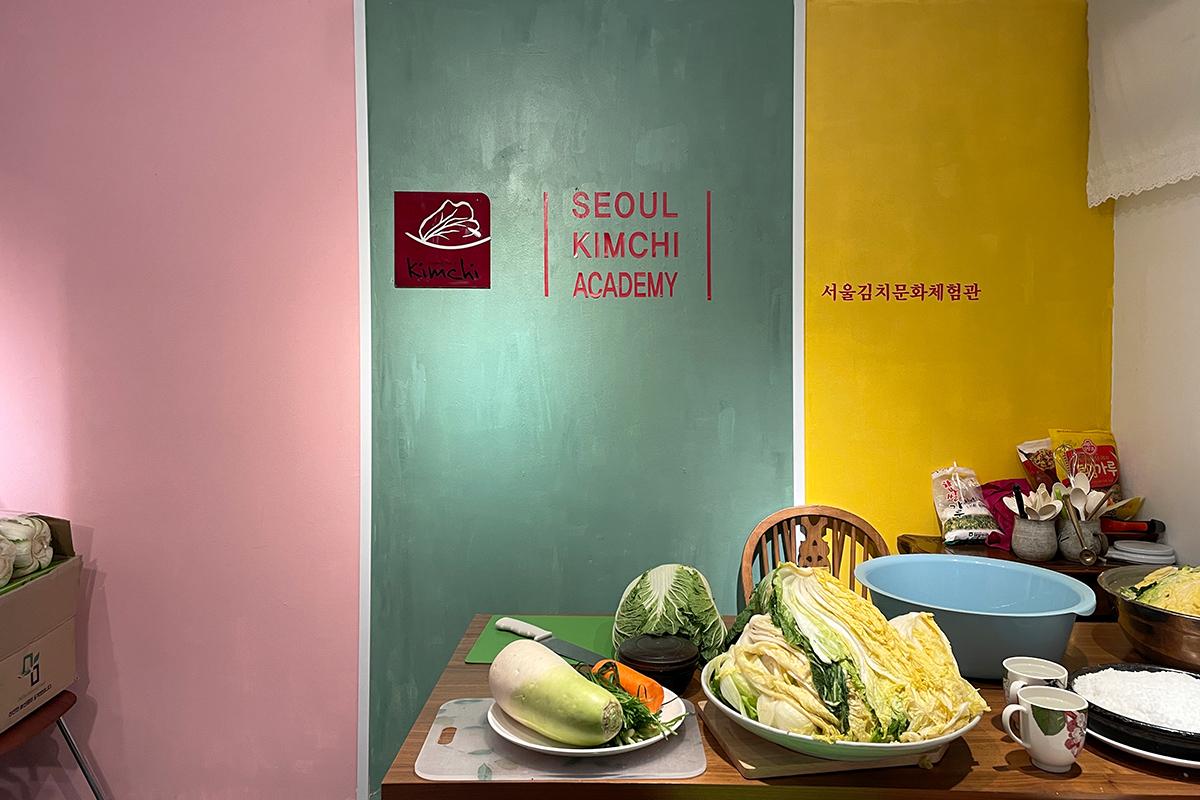
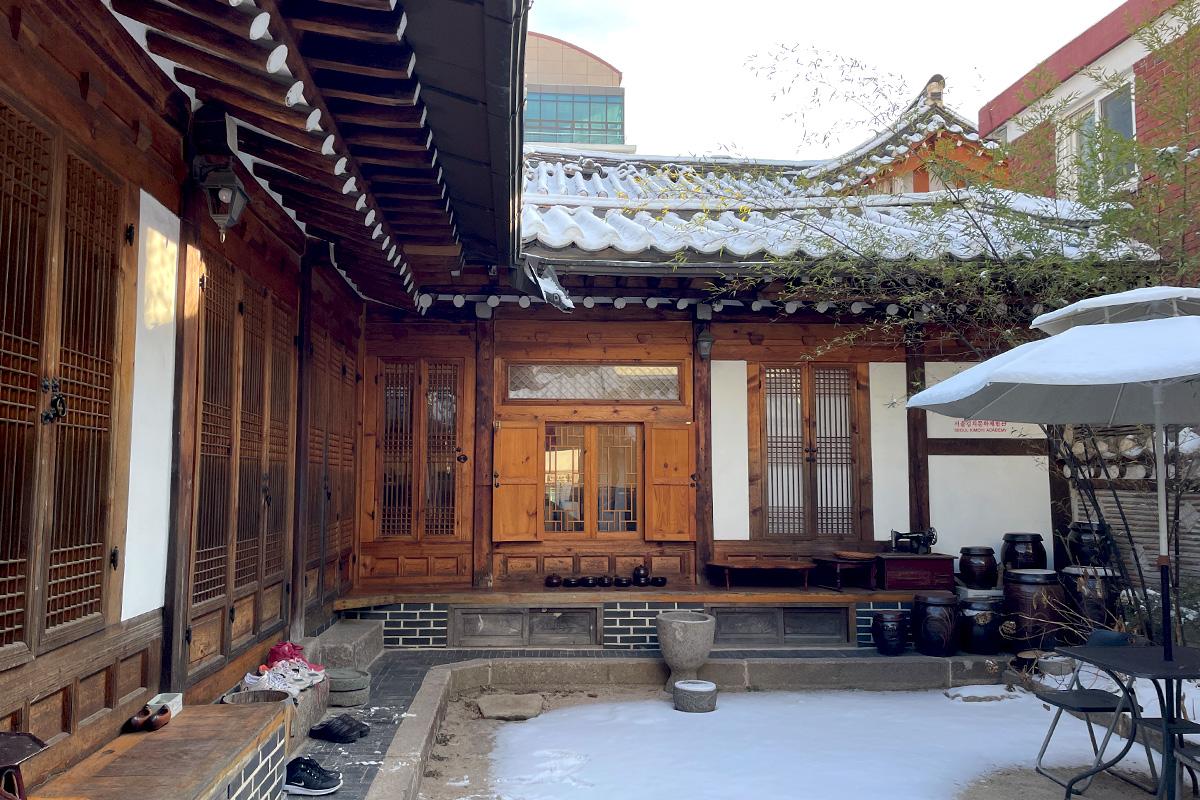
Kimchi is the most common Korean traditional dish and cannot be left out of a Korean meal. At the Kimchi Academy, you can learn to make your very own kimchi!
When you arrive at the Kimchi Academy, there will be a long table with ingredients and cooking utensils prepared for all the people who made a reservation.
The instructor will be wearing a traditional Hanbok and will use a microphone to teach you how to make kimchi. The course is mostly in Korean but the instructor is also able to give basic instructions in English and Japanese! There are also other side instructors that can speak English and Japanese, so you won't have to worry about the language barrier.
Credit: Kimchi Academy Homepage
To make cabbage kimchi, the radish is julienned and mixed in with the seasoning, then stuffed in between the cabbage leaves. Once the cabbage is all stuffed and seasoned, it is wrapped up into a round shape to finish it off!
If you make a reservation for the Special Course, which is a course that is also used to train professionals, you can make a wide variety of kimchi, including cabbage kimchi, fresh kimchi, bossam kimchi, cucumber kimchi, and radish kimchi.
Credit: Kimchi Academy Homepage
The finished product can be taken home in a vacuum-sealed package, so you don't have to worry about it leaking and enjoy the kimchi you personally made at home!
After making kimchi, there will be time to make and eat kimchi pancakes! These Korean pancakes are made with kimchi, batter, and other vegetables and are crispy on the outside and soft on the inside. They're delicious!
Being able to make Korea's most famous traditional dish, kimchi, in Korea will be a really meaningful and memorable experience. Don't miss out on this opportunity to make your very own kimchi here and in Korea and experience the culture in a unique and meaningful way!
Our Visit
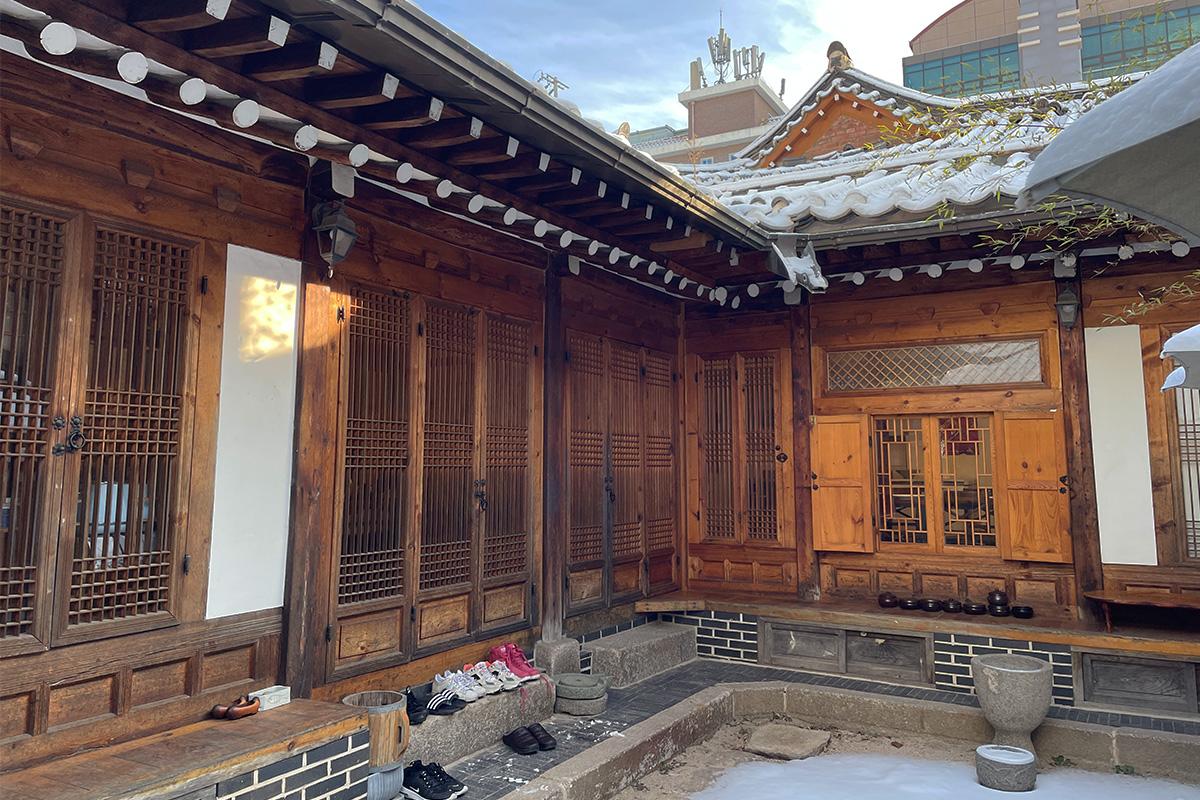
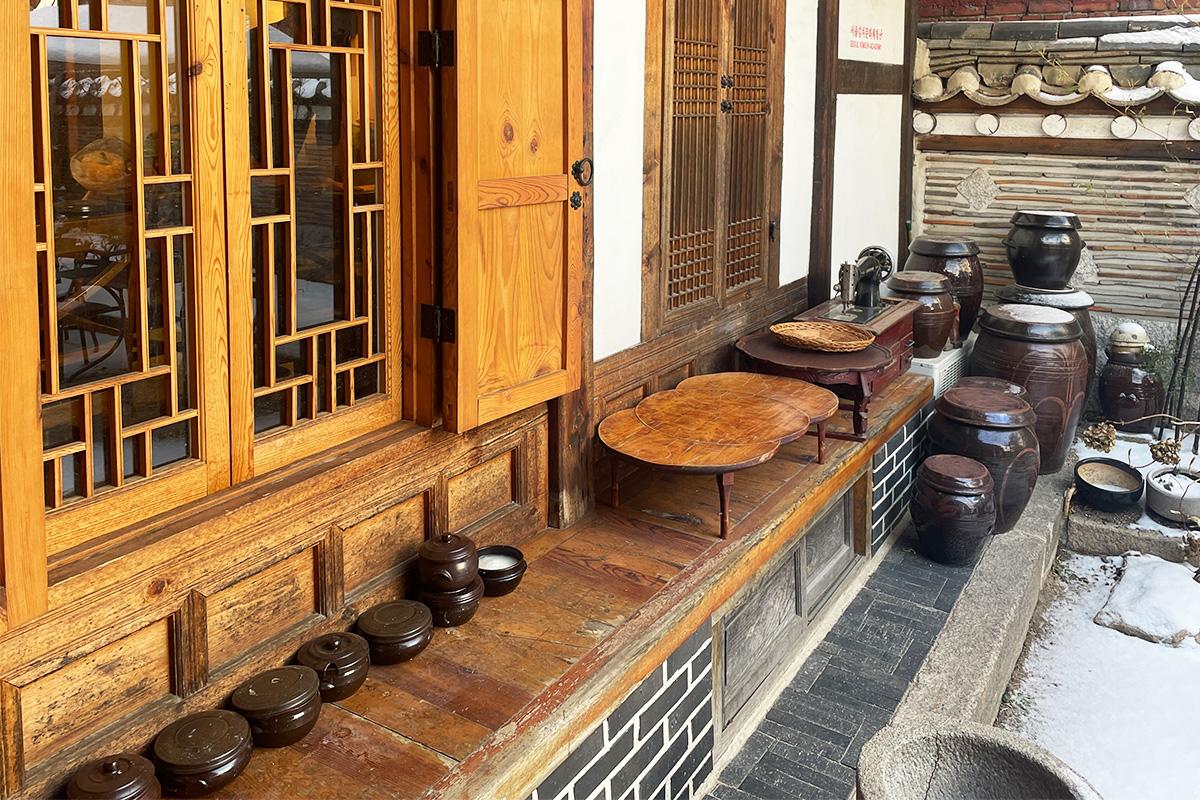
When you arrive at the Kimchi Academy and step into the gates, you'll get to see what the inside of a traditional Korean hanok looks like. Foreigners often see the exterior of a hanok but rarely get to see the inside of one. Foreigners that come to Kimchi Academy are left in awe of the unique structure of the traditional Korean housing.
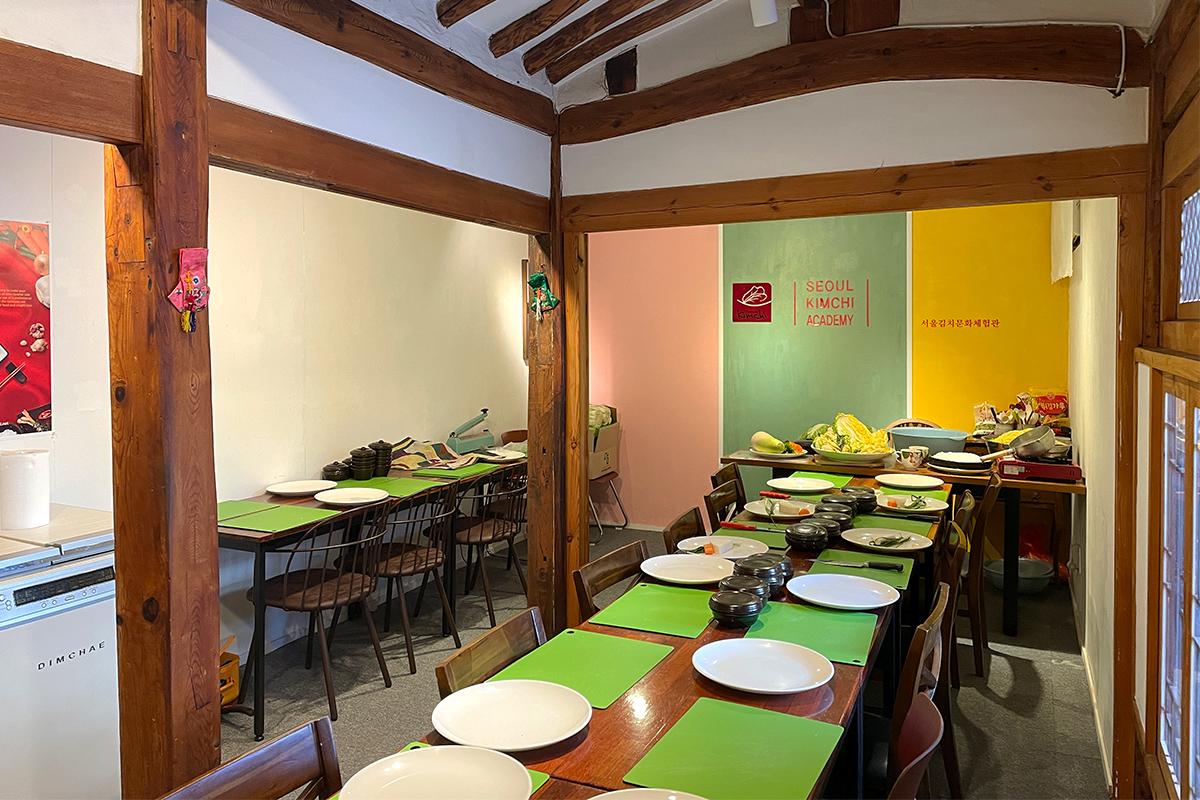
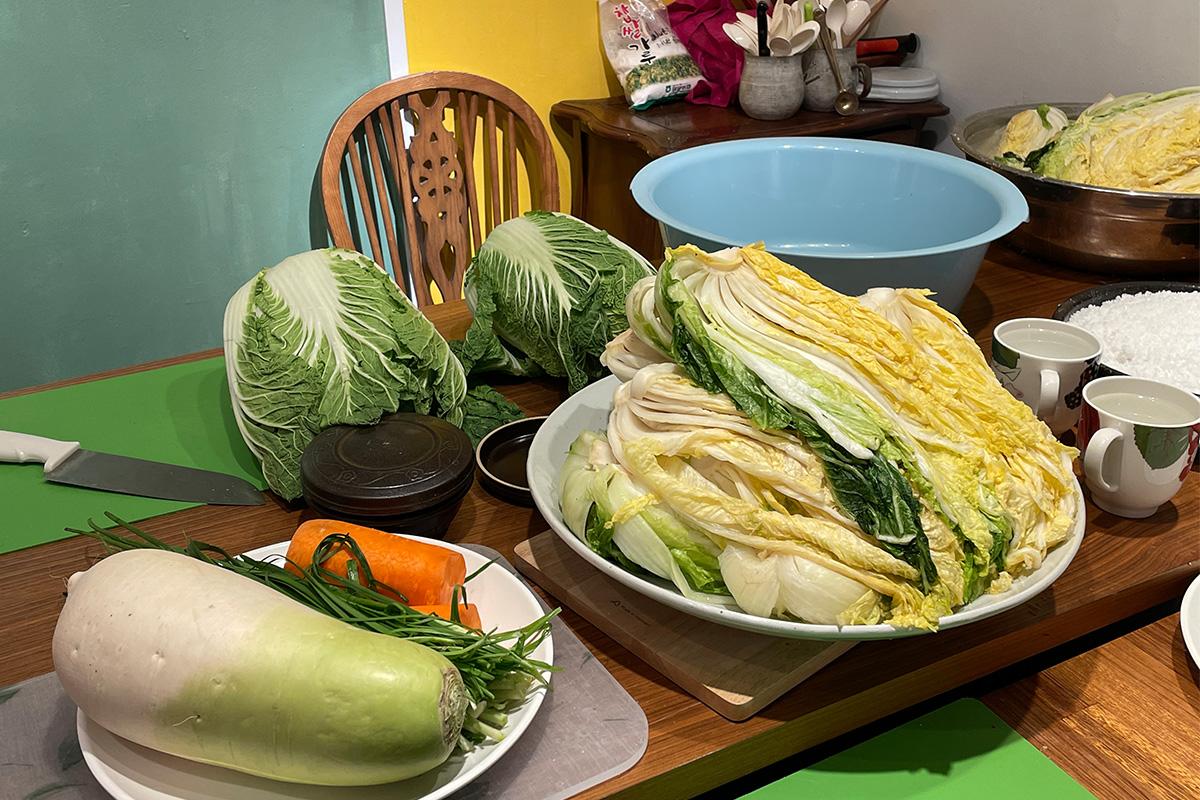
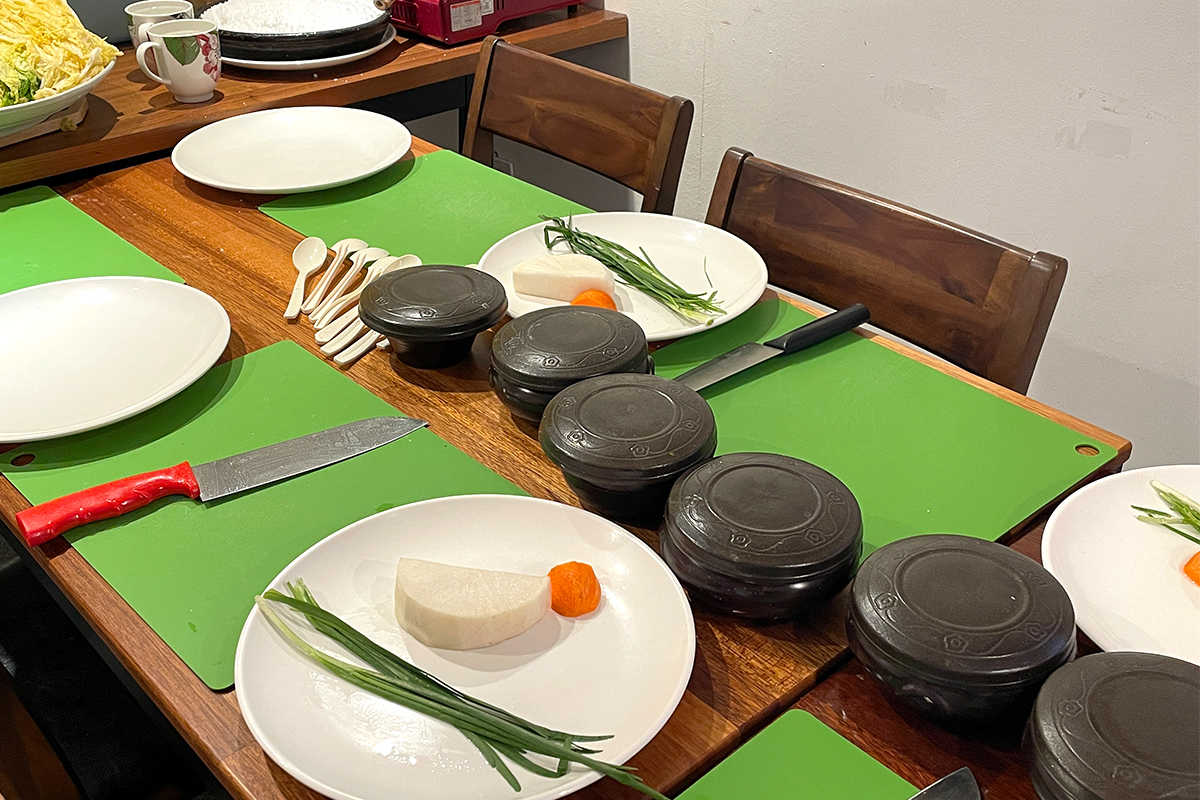
When we stepped into the hanok, there was a spacious room where the kimchi-making classes took place. The classroom can fit up to 20 people.
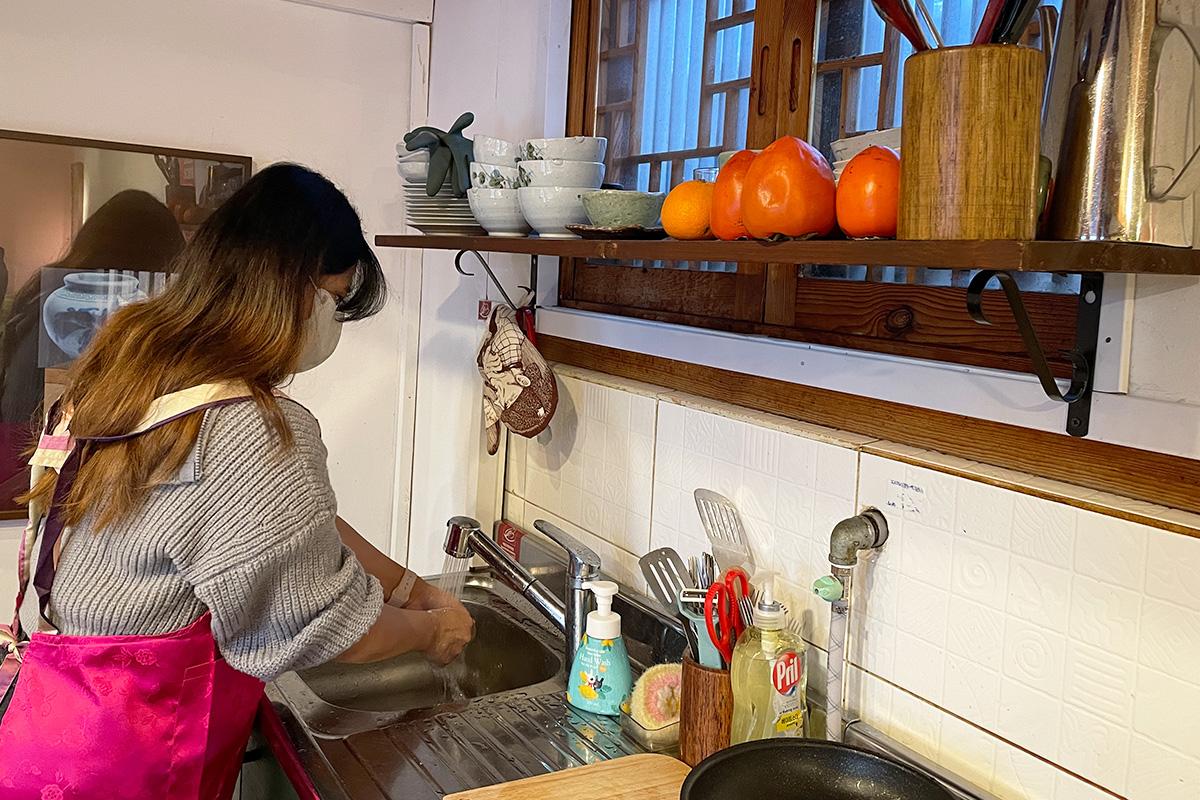
The most important aspect of cooking is hygiene. Kimchi Academy takes great care of its environment so you won't have to worry about hygiene. Before the class starts, the instructor will tell you to wash your hands.
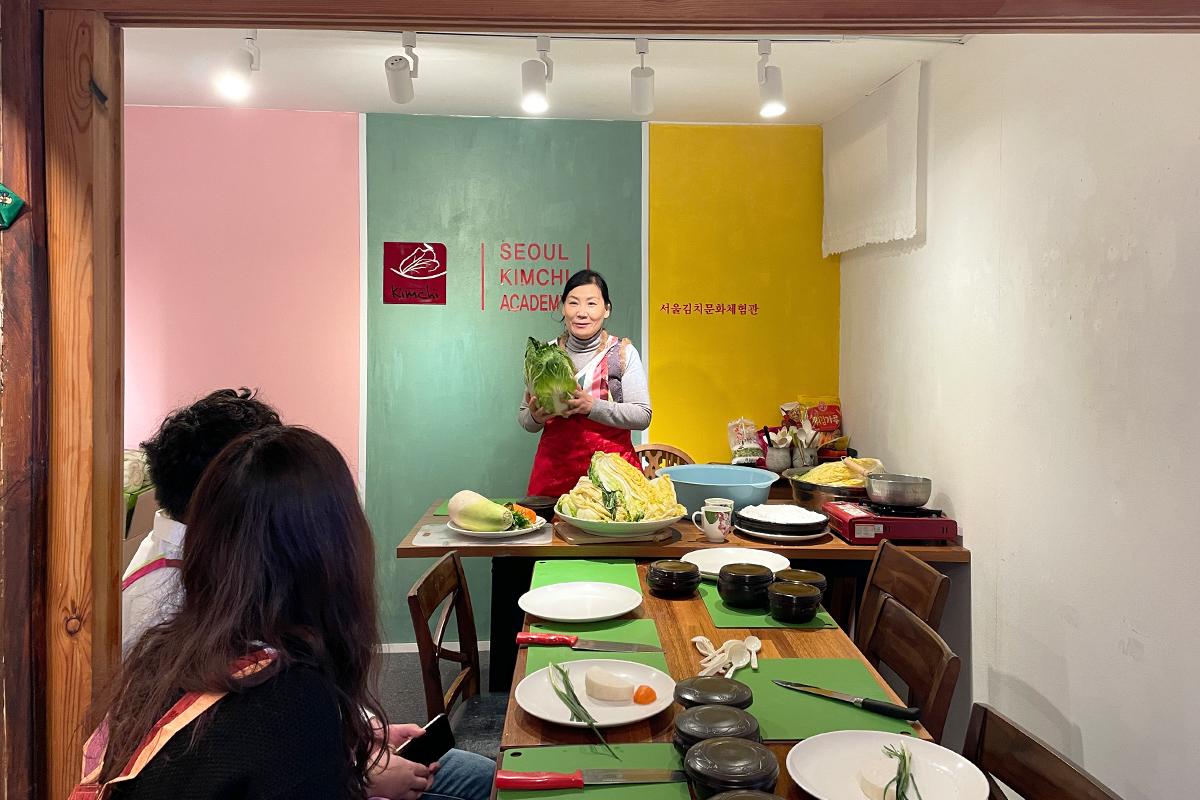
An introduction by the lead instructor is given for approximately 5 minutes. She briefly explains what goes into the process of making kimchi and what ingredients are used. She instructs the class in English or Japanese, so don't worry about not being able to understand the class! Kimchi Academy uses the freshest produce for their kimchi, which really affects the taste!
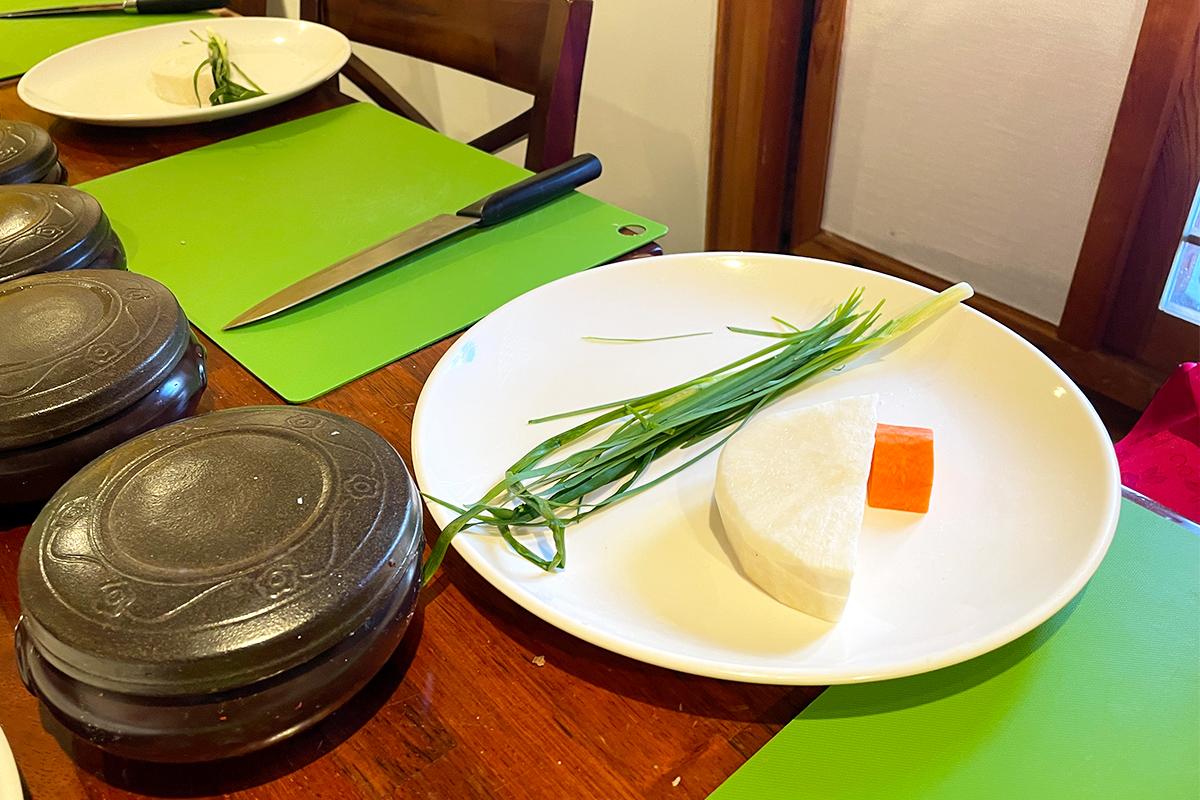
After the introduction, it's time to get out hands busy! At your seat, there will be radishes, carrots, and chives prepared for you to cut.
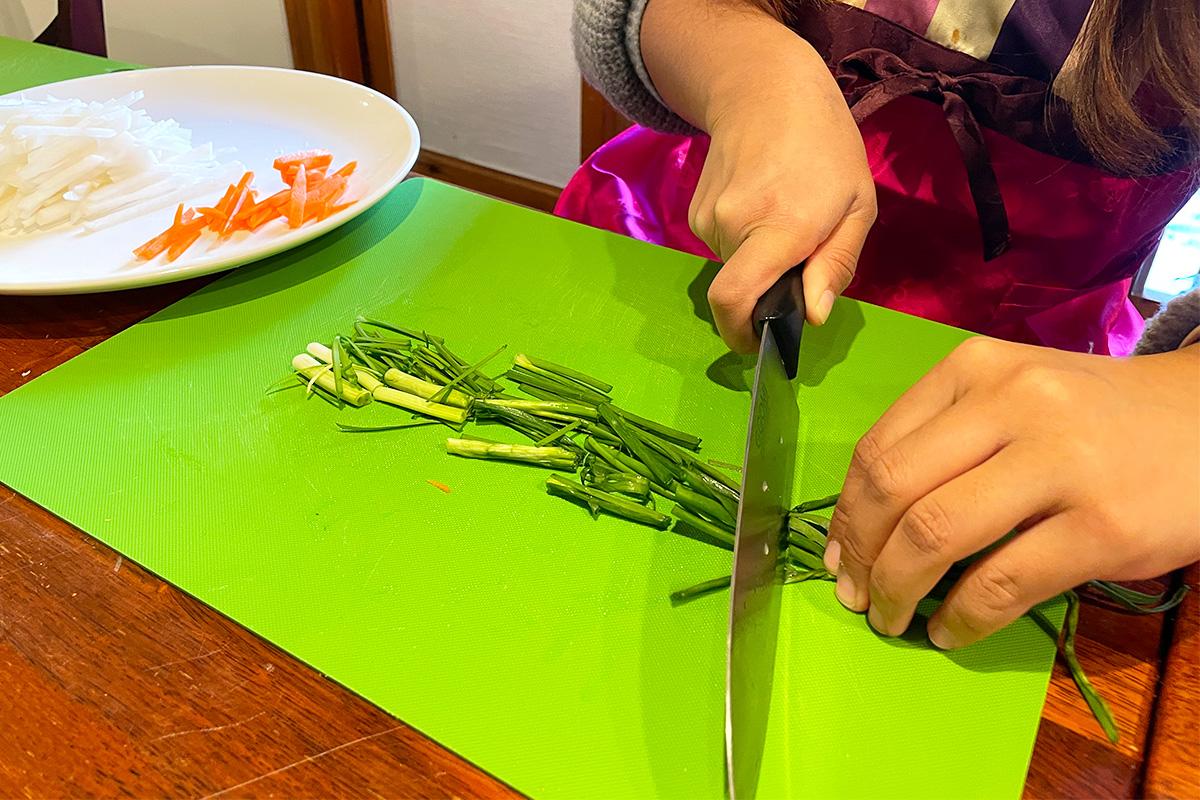
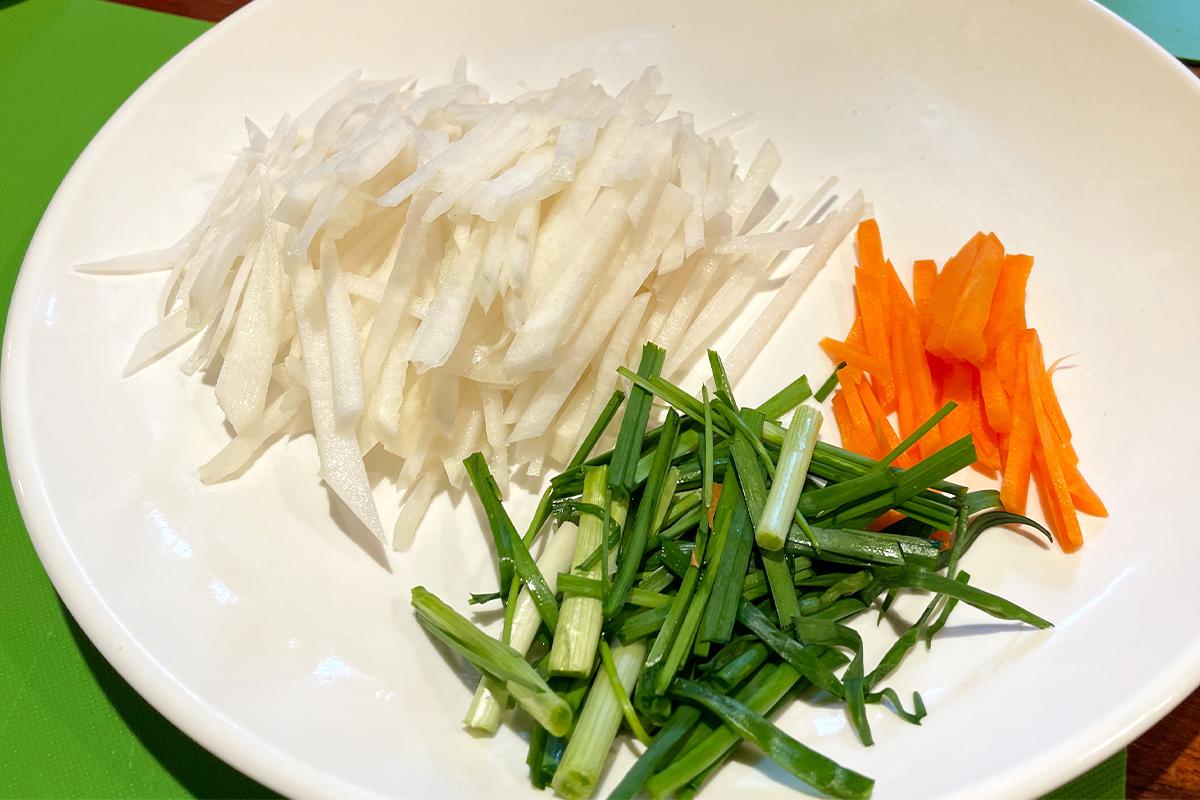
Julienne the vegetables so they are equal in size. The radish and carrot should be long and thin, and the chives should be approximately 3-5 cm long. If you have trouble using a knife, don't worry! The instructor will assist you.
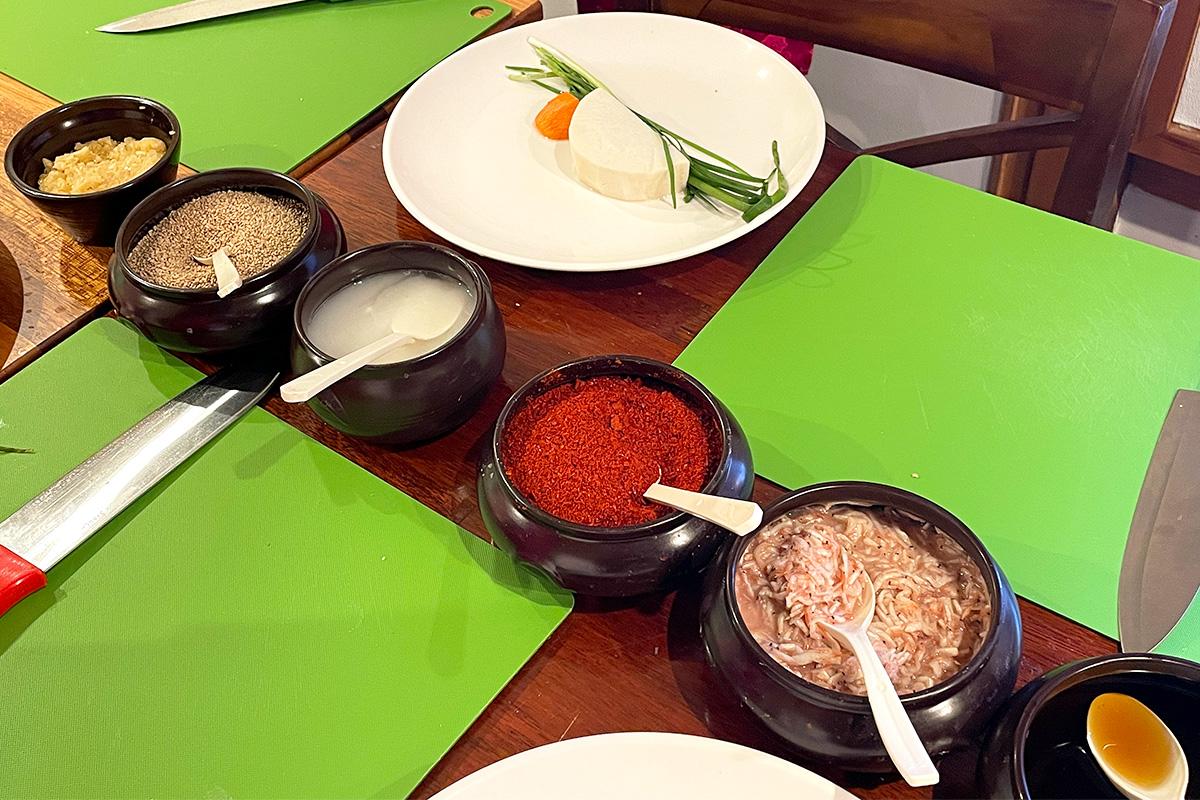
After you've cut all the vegetables, it's time to make the kimchi paste. The seasoning pictures above will determine the taste of the kimchi. Shrimp paste, anchovy fish sauce, sugar, sesame, chili powder, and rice slurry are the main ingredients.
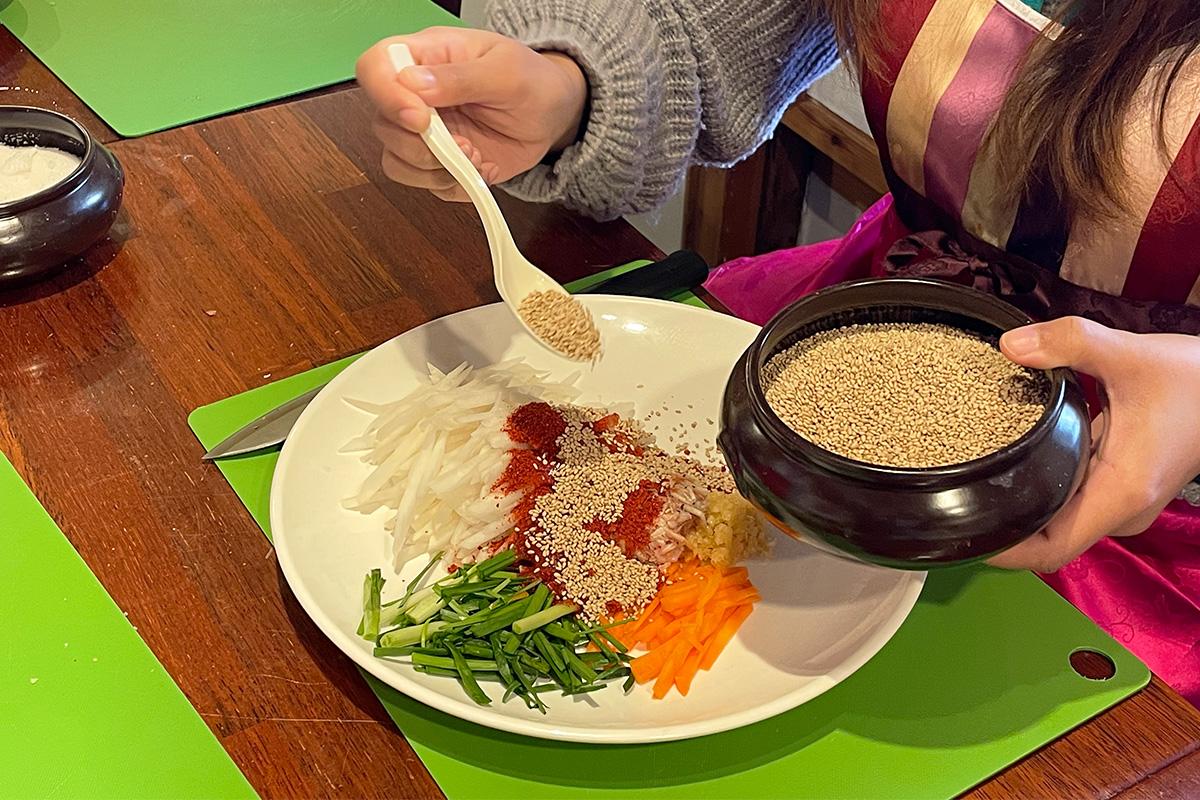
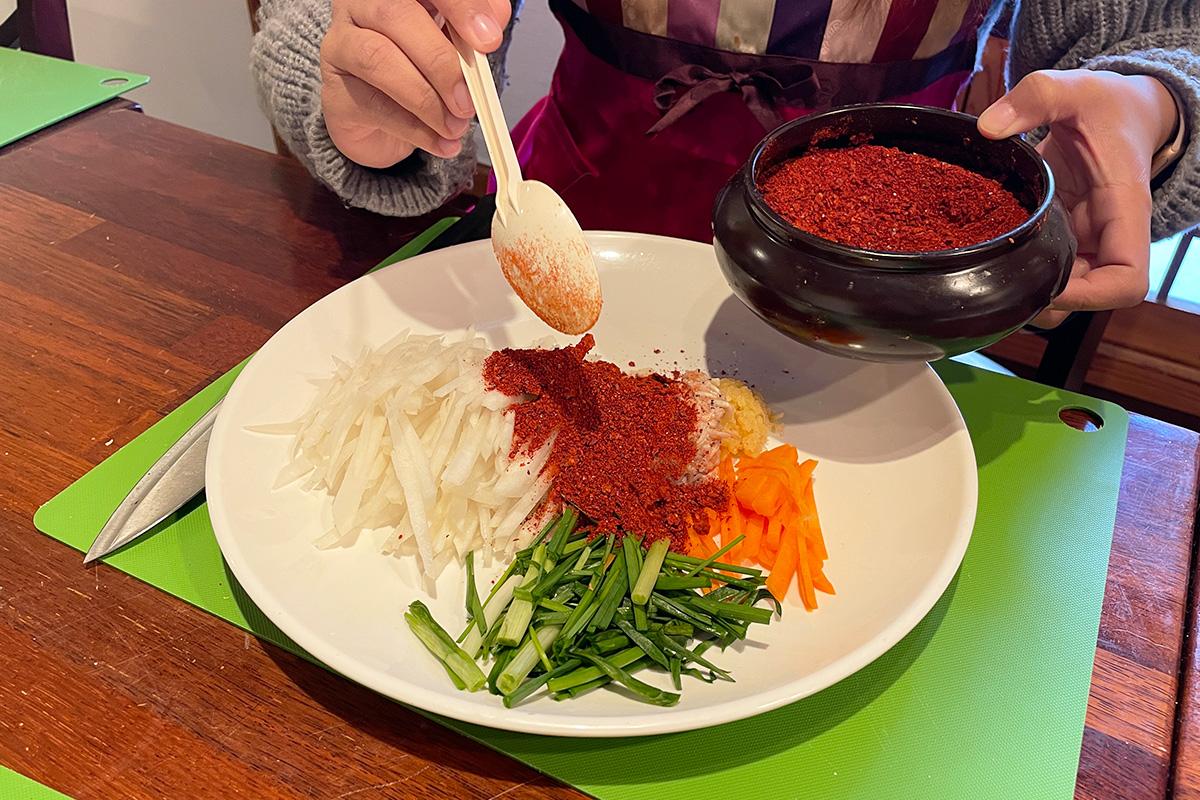
Put a tablespoon of each of the ingredients on top of the prepared vegetables. You can control the amount of spice by putting in as little or more chili powder as you like.
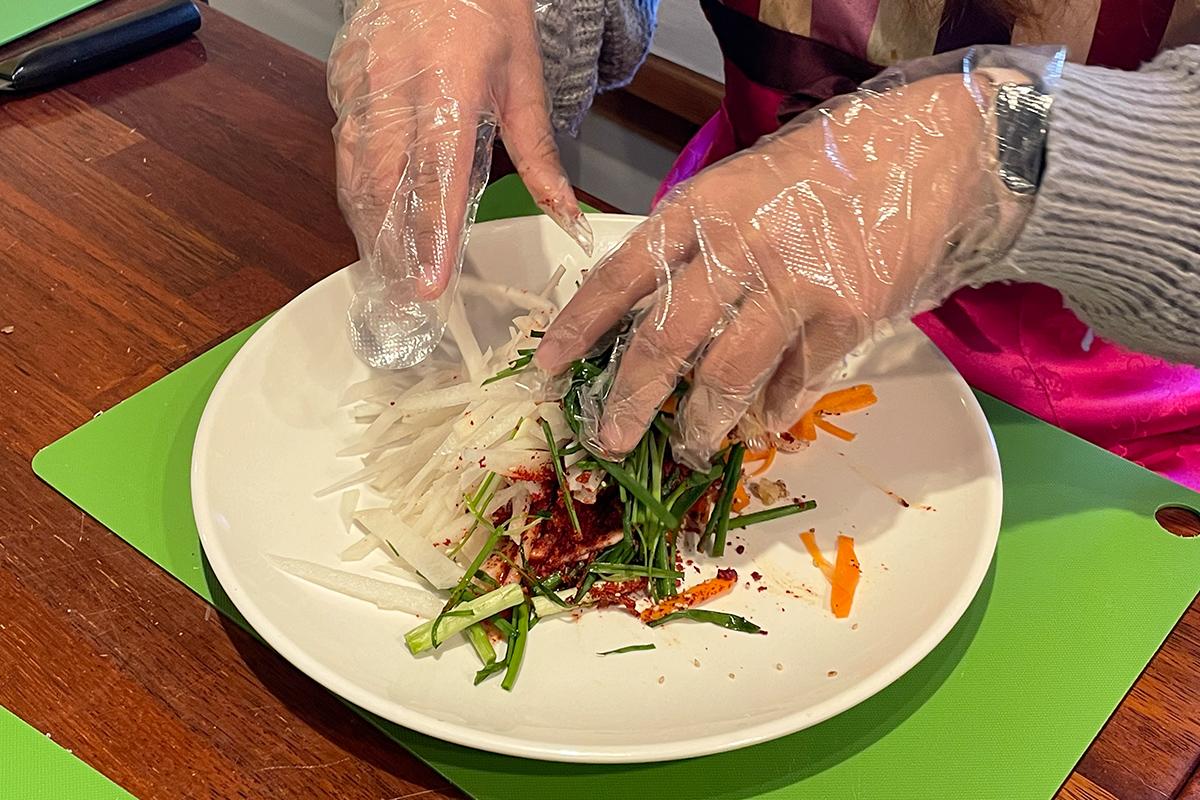
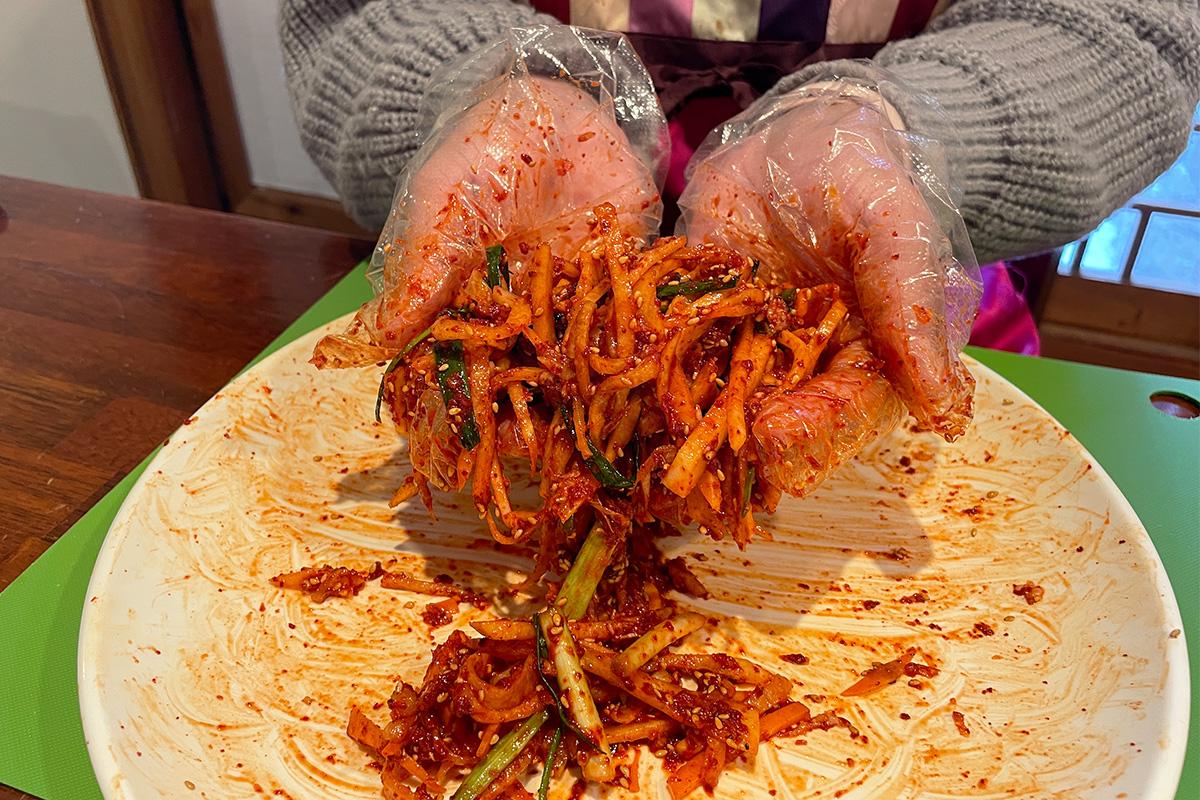
Put on your gloves and mix away! When the vegetables and paste are mixed well, paste it in between each cabbage leaf.
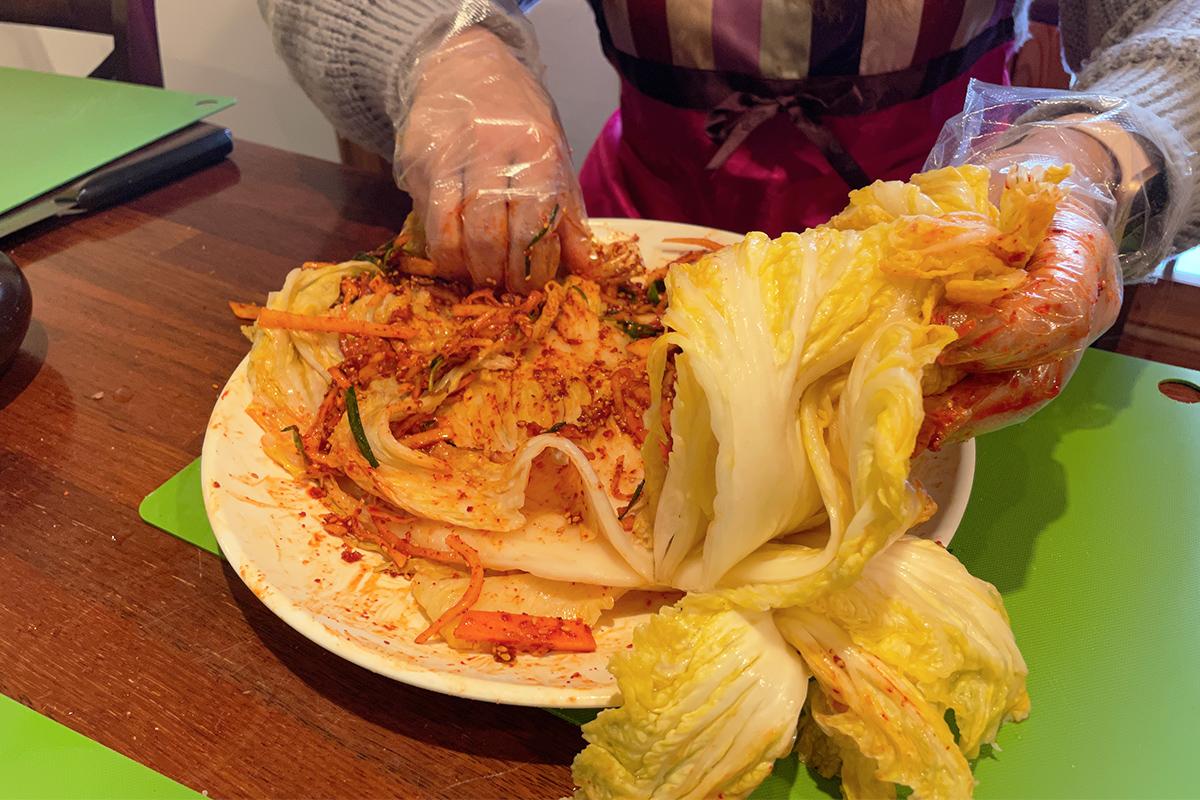
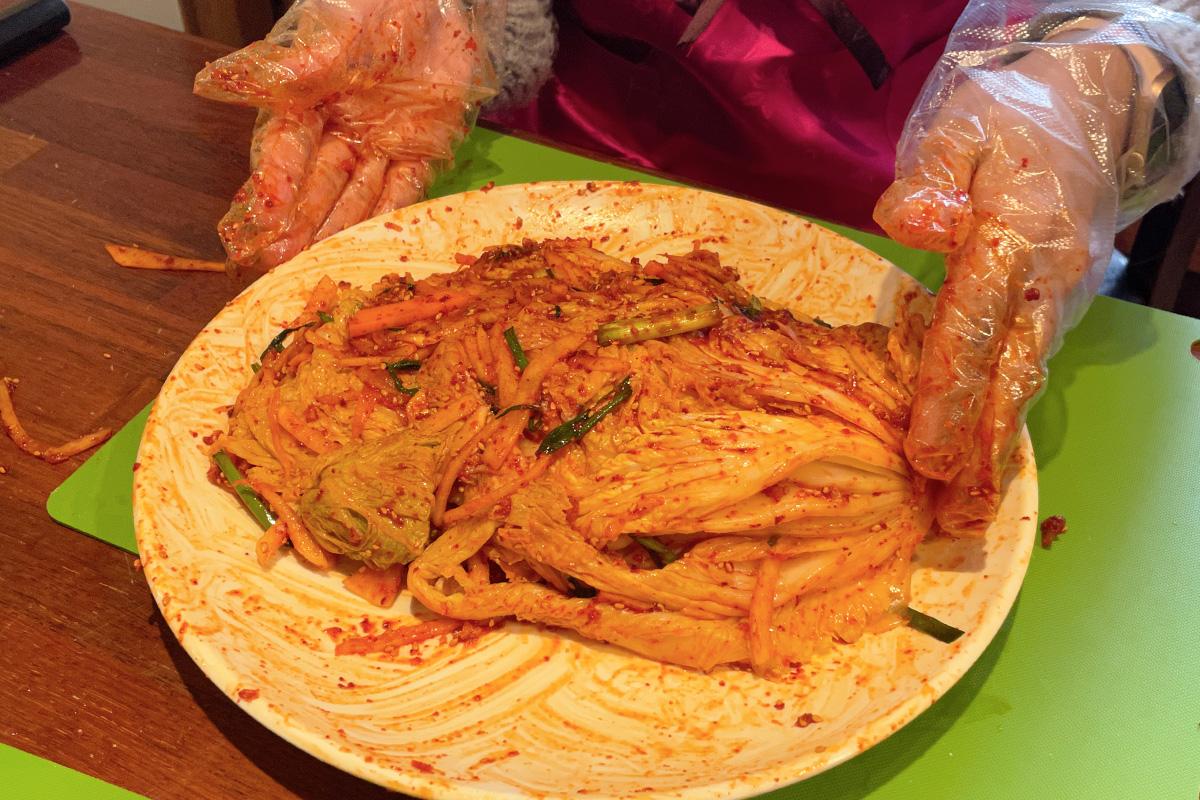
Make sure the white parts of the cabbage are completely covered in the paste. The cabbage has already been pickled in salt brine, so it will be wilted and malleable. The salt used to brine the cabbage is sea salt, which brings out the flavor of the kimchi so well.
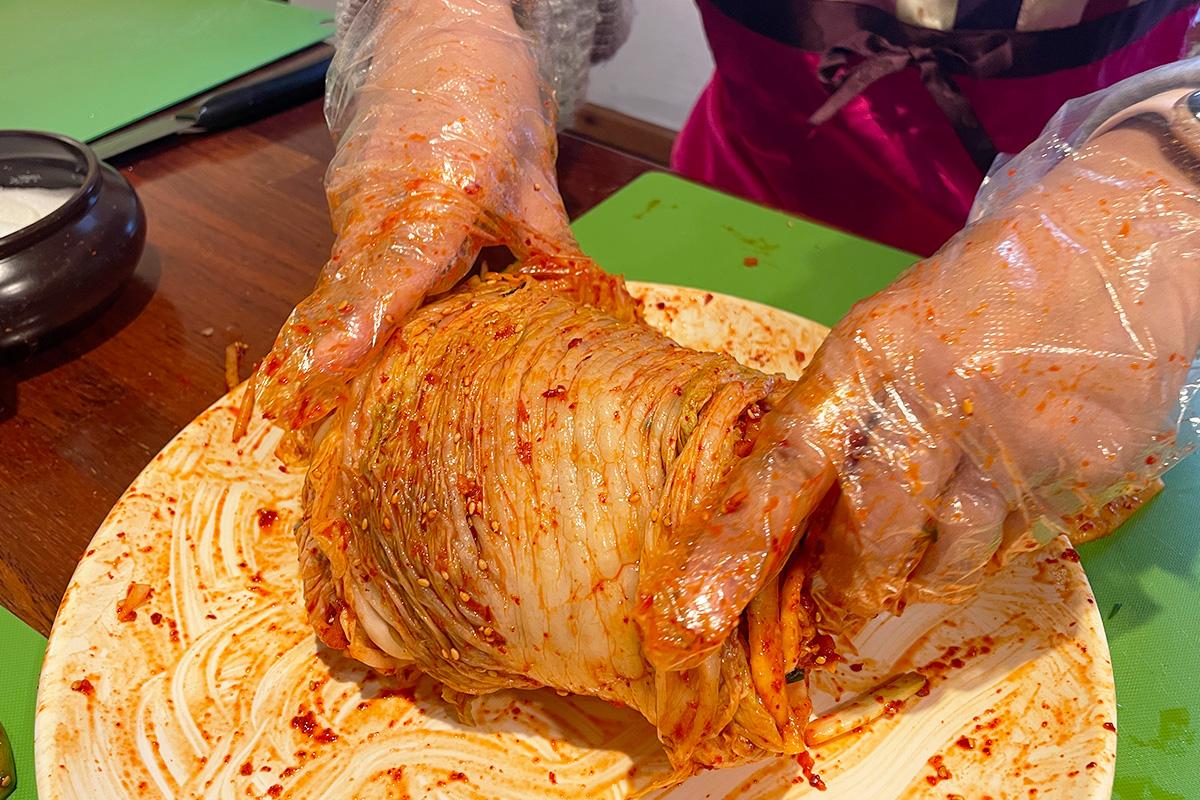
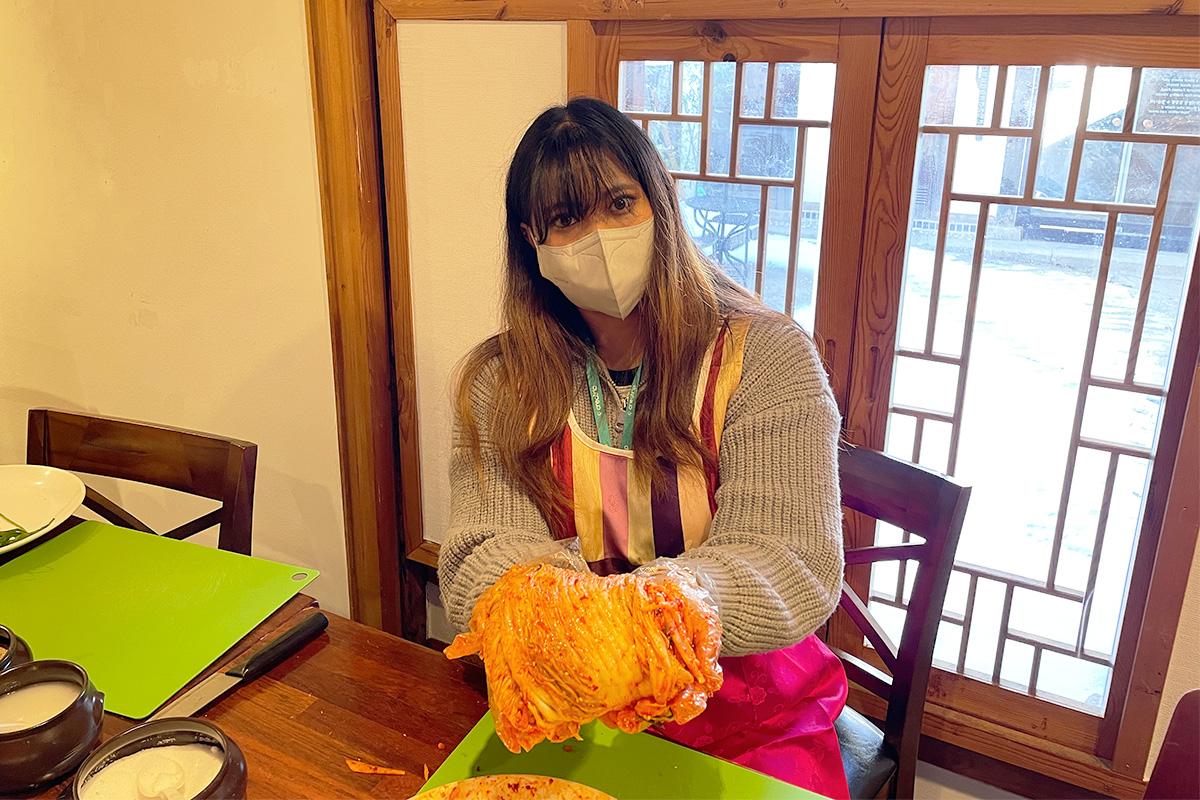
If the kimchi paste is inside and all around the cabbage, your kimchi is done! You will need to roll up the cabbage so it's easier to store. Making kimchi is easier than you'd expect!
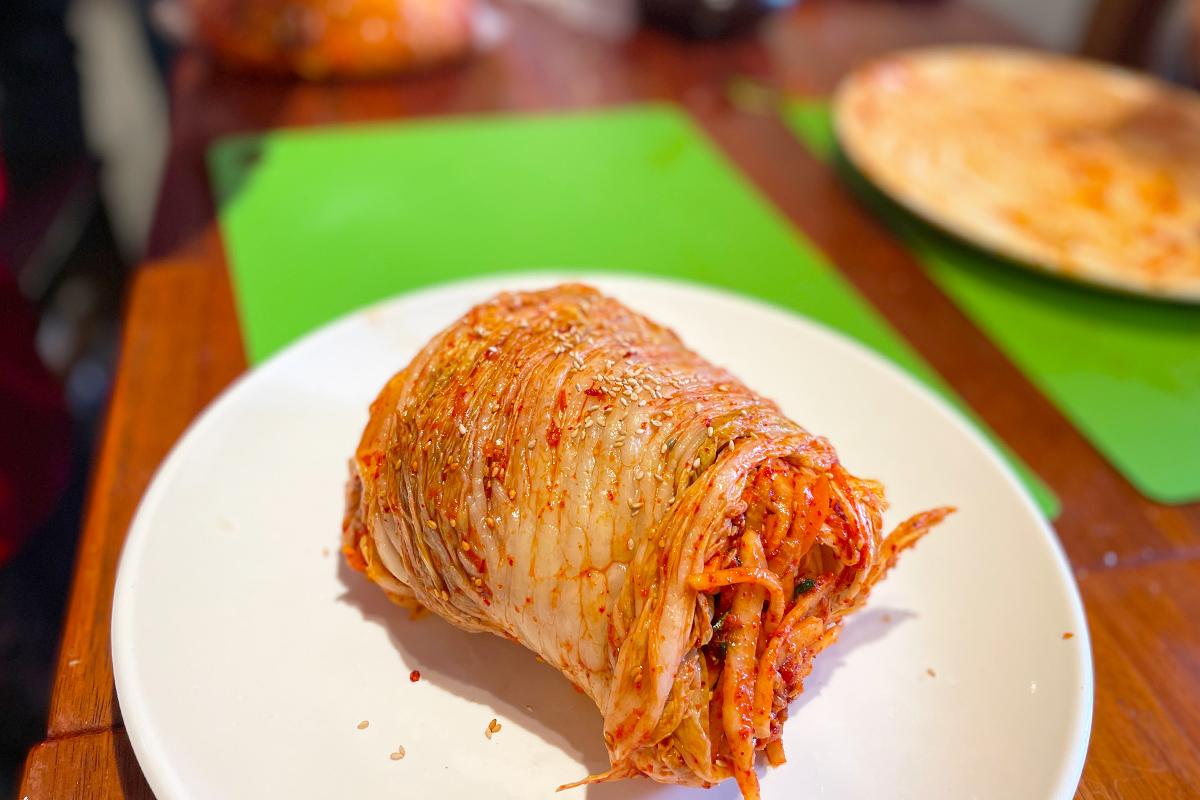
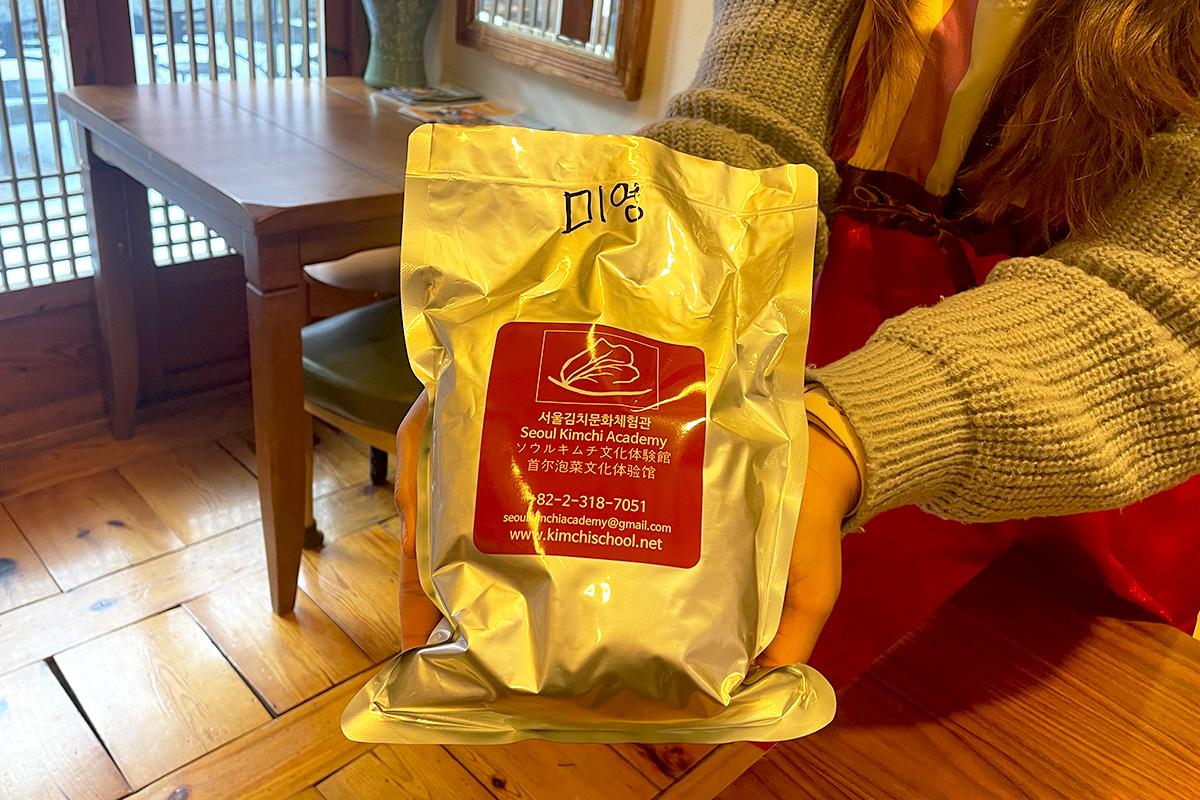
Your kimchi will be packed in a vacuum-sealed bag with your name on it for you to take home! You can eat the kimchi right away and it can sit in your fridge for up to 3 months! After 2-3 weeks, it will start to over-ferment, which can leave a sour taste, but most Korean kimchis are fermented this way, so you can leave it if that's what you prefer!
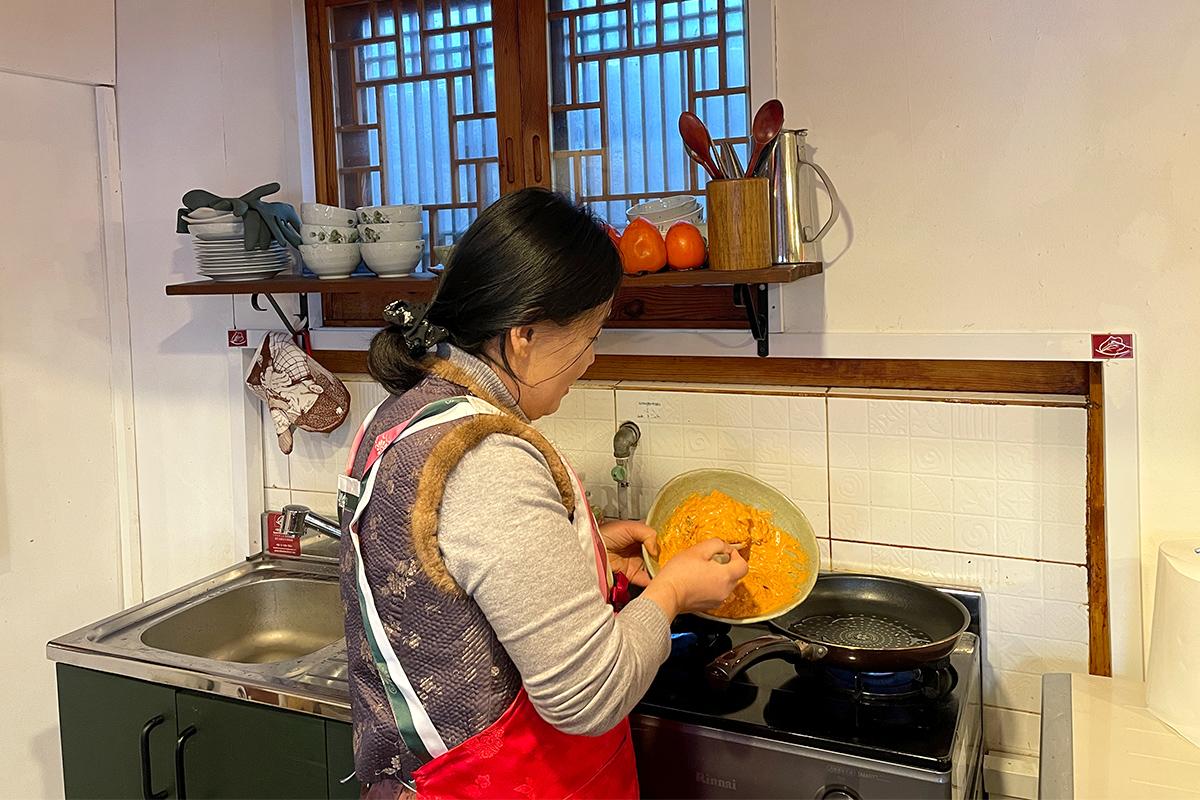
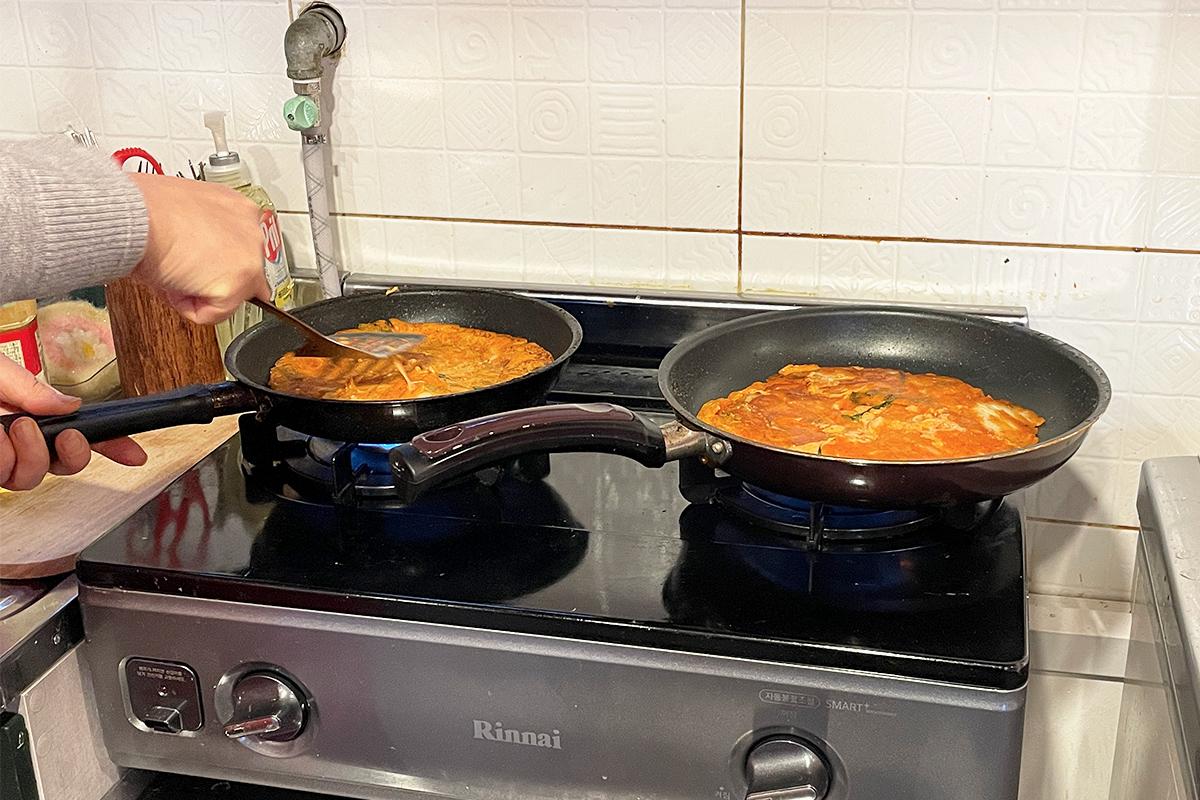
The class may be over, but it's not time to go home just yet! The instructor will show you how to make kimchi pancakes which consist of flour, kimchi, and water mixed into a batter and fried in oil! The smell of the kimchi pancakes will temporarily take you to heaven. The 10 minutes it takes to cook the pancakes will feel like 30.
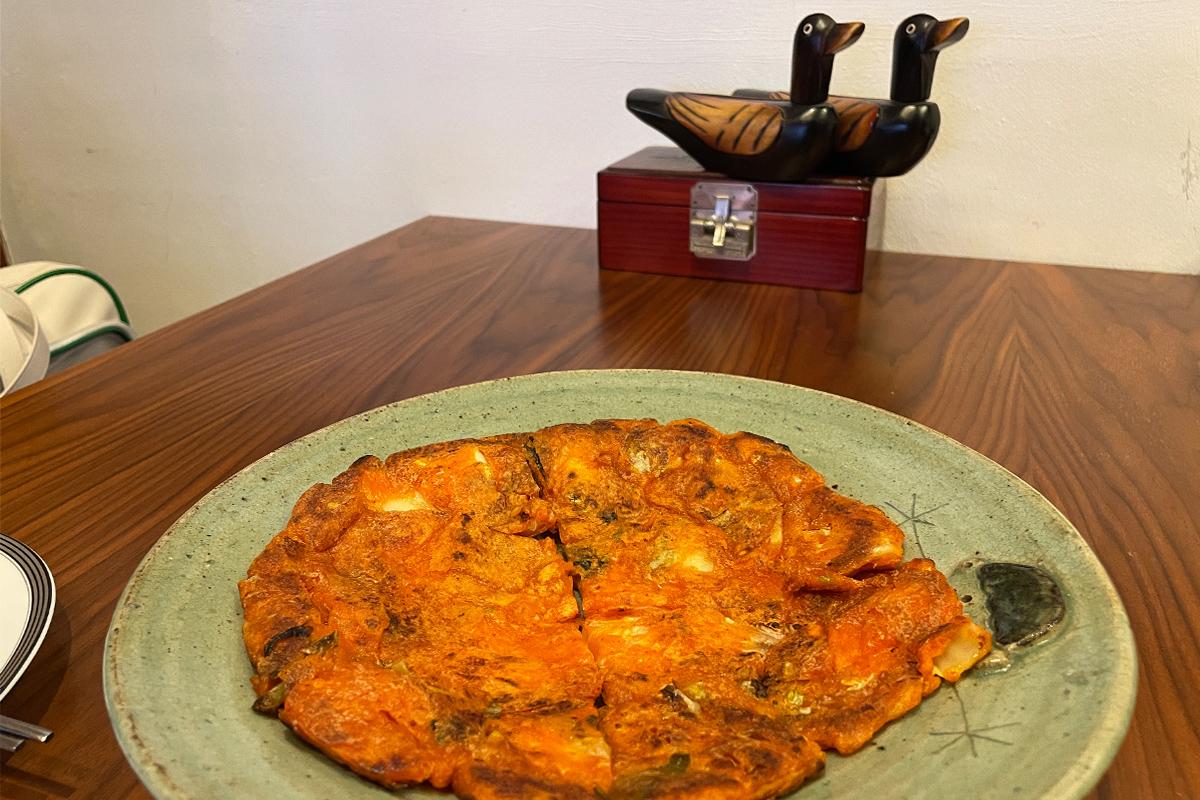
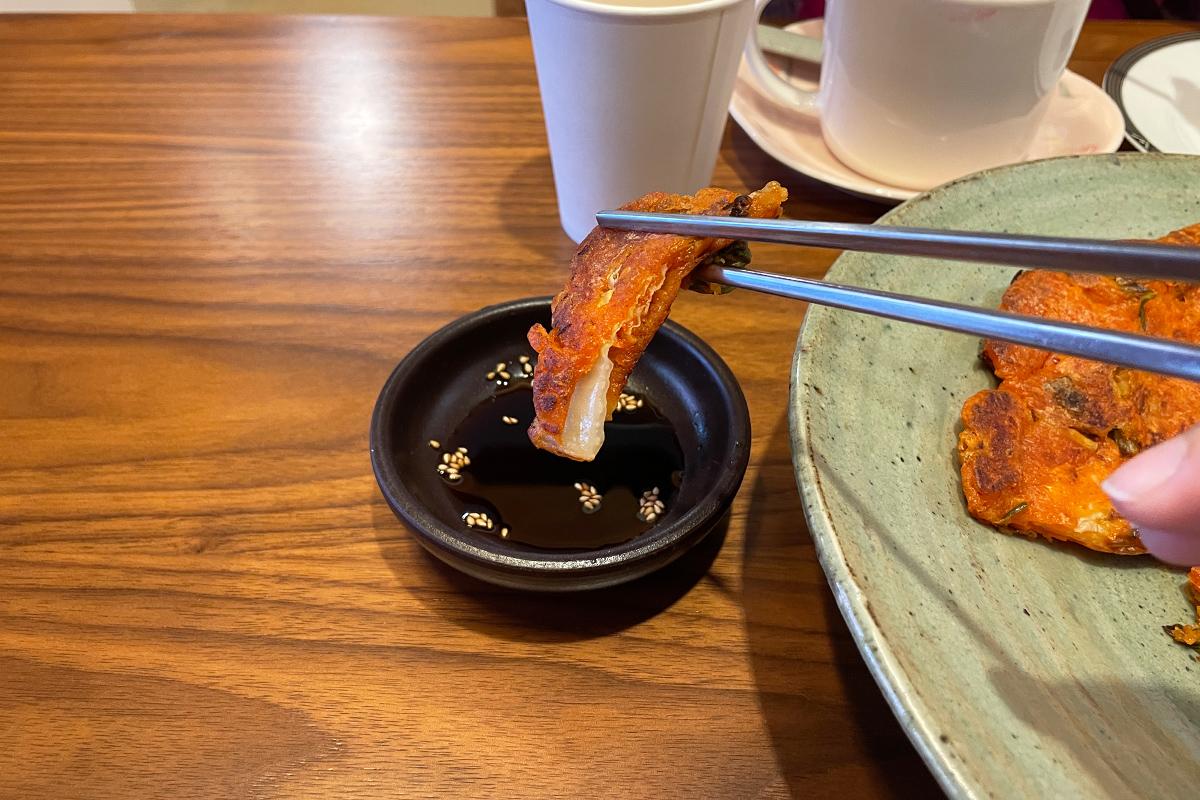
You will get to try the kimchi pancakes right out of the pan! It is not spicy at all and is a totally different flavor from kimchi itself. When you're finished with the kimchi pancakes, the 1-hour course is done. You'll get to go home with a deeper understanding of Korean cuisine!
Kimchi Academy
We hope you can enjoy your time making kimchi! If you have any questions or concerns, please leave a comment below or send us an email at help@creatrip.com! You can follow us on Instagram, TikTok, Twitter, and Facebook to stay updated on all things Korea!

